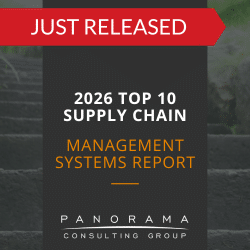A poorly-managed enterprise software implementation can affect every corner of your business, including your warehouse.
Have you noticed that warehouse operations have become increasingly difficult since you went live with your new software system? If so, this may be considered a software implementation failure.
This means you may need a different software system, or you may need to revisit your change management and business process management efforts.
Today, we’re outlining the warehouse management challenges that can result from a failed software implementation. We’ll also share expert tips to help you fix these issues while recovering from implementation failure.
5 Warehouse Management Challenges That May Mean You Need Project Recovery
1. Inaccurate Inventory Data
When your inventory management system isn’t working as it should, it can cause several problems within your warehouse.
For one, it makes the picking process more challenging. Pickers may go to a designated area to pick a product, only to find that it’s not on the shelf. Or, the system might send products to a particular shelf, but it’s too full.
If your software was poorly implemented, you’re probably resorting to manual inventory updates. These updates may be riddled with user errors, leading to issues such as:
- Incorrect stock information
- Obsolete inventory buildup
- Excessive error remediation
Implementing a different enterprise software system could potentially solve these problems. Look for one that includes automated inventory management and optimization features to automate manual processing and eliminate errors.
Contemplating litigation?
We have multiple software expert witnesses available for provision of reports, depositions, and testimonies.
2. Redundant Actions
A successful warehouse operates like a well-oiled machine. Everyone knows their role and performs it concurrently with other departments.
However, if your software system is inadequate, it’s easy for wires to get crossed. In fact, you might find that multiple people are performing the same action at the same time, without realizing it.
This is often a direct result of poorly managed workflows. It’s especially common in large warehouses, where operations are more dispersed, and employees aren’t working side-by-side.
Once you recognize areas in your warehouse that are prone to redundancy, you can take corrective measures. Either rework your processes or look for a better software system – perhaps a robust warehouse execution system (WES) that can automate processes and notify users of any duplicate actions. Many of these systems use barcode scanners to update the system once an order has been picked, so employees always know which tasks are finished.
3. Inefficient Warehouse Optimization
A properly configured warehouse makes the best use of every square inch, including floor space and vertical space. When yours is designed correctly, you can easily store products, and employees can move around safely and efficiently.
Yet, the opposite holds true if your design is lacking. An improper warehouse setup can leave workers scrambling to search for high-demand, fast-moving items. You might find they’re spending copious amounts of time manually looking for these items when they could be performing higher-level tasks.
If you’re experiencing this issue, we recommend reconfiguring your warehouse process management. Look at your current workflows and identify pain points and bottlenecks. Then, redesign those processes to help your space operate more effectively.
Also, make sure you’ve implemented the right manufacturing ERP system or warehouse management system (WMS). What capabilities does it have? Does it fulfill your highest-priority requirements?
For example, can you enter the dimensions and measurements of your warehouse and inventory to view a 3D model of the most optimal layout for your space?
4. Reverting to Manual Processes
When new technology fails, users go back to what’s familiar. In this case, you might find that workers are resorting to manual processes to fulfill orders. Not only is this time-consuming and costly, but it leads to the aforementioned user errors.
Research shows that 87% of industry decision-makers are currently expanding their warehouses or plan to expand them by 2024. At the same time, 77% of organizations are seriously focused on automated warehouse systems and using them to maximize data-driven performance.
Clearly, growth and technology go hand-in-hand, and you can’t have one without the other. Whether it’s an enterprise-wide platform or a barcode scanner, your bottom line can benefit – but only if employees are properly using the technology.
If your teams are performing routine actions outside of the new software, you could be setting your warehouse up for failure. You may need invest in robust organizational change management to ensure your employees have the knowledge and motivation required to confidently adopt the new system.
5. Inability to Meet Seasonal Demands
Does your business enjoy an uptick in activity during certain parts of the year? If so, it’s important to prepare ahead of time for these surges in demand.
Your warehouse should be prepared to take new orders, with enough inventory on hand to fulfill them. If you’re caught by surprise, you may be unable to meet customer requirements, which can mean a direct hit to your reputation.
While a supply chain management system can be valuable is this respect, a poorly-implemented one can be useless.
Is your platform automating and optimizing every touchpoint as a product travels from initial procurement to final delivery? Do users have real-time visibility into operations, so employees are always in the loop?
If not, you need to close the gap between the warehouse and other parts of the supply chain, such as transportation. Find out if your system can be configured to better provide real-time data. At the same time, find out if your employees can better learn how to access this data. Users should be able to access data to change product placement, order in-demand stocks, properly manage transportation, and successfully meet demand.
A Failed Software Implementation Doesn’t Have to Derail Your Warehouse
Sometimes, failures aren’t immediately obvious. You may only realize something is wrong when your processes and systems start to break down.
The good news is you can recover your project before your warehouse completely derails. If you notice any of these warehouse management challenges, don’t sweep them under the rug. Get moving on project recovery now!
Our software expert witness team can provide project recovery services and guide you in a new direction. Contact us below for a free consultation.














